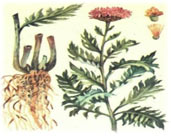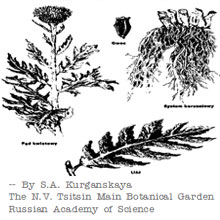
Outside Russia, Maral root is found only in Mongolia. It grows in sufficiently moistened alpine-meadow, podsolized soils; it is abundantly represented in such habitats as tall-grass subalpine meadows, while in the mountain forest areas it is found in forest meadows and open fir-pine forests. Rarely, maral root is found in alpine meadows. For the first time, in the scientific literature the plant was mentioned in a paper of G.N. Potanin, Russian explorer of Siberia and ethnographer. On commission of the Imperial Russian Geographic Society, G.N. Potanin went on an expedition to northwestern Mongolia, where in 1879 he noted down a tale, narrated by a Mongolian passer-by, about a grass, the roots of which are dug out and eaten by marals (Asiatic red deer). That is why Russian trailblazers in the Altai named it maral root. In Mongolia, the plant is called bukhu ("vigor" in Mongolian). From time immemorial, the plant's roots and herbs have been used in the folk medicines of Siberians and Mongolians as a stimulant.
 Maral root decoctions and infusions are prescribed as restoratives and tonics in case of fatigue and weakness, especially for recovering patients and the elderly.
Maral root decoctions and infusions are prescribed as restoratives and tonics in case of fatigue and weakness, especially for recovering patients and the elderly.
In Tibet medicine, maral root is included in mixtures prescribed for pulmonary and kidney diseases, jaundice, fever, and angina. The pharmacological and clinical studies of maral root was begun in the 1940s at the Tomsk Medical University. Since 1961, maral rootstock alcoholic extracts and tinctures have been authorized for functional derangements of the nervous system, for excessive mental and physical fatigues, and as a stimulant for enhancing mental and physical efficiency. Their tonic effect is conditioned by the availability of ecdysteronum, a biologically active substance recently found in the plant. Ecdysteronum has a psychostimulating effect. Besides, the plant's roots and rootstocks contain alkaloids, coumarins, anthraquinones, flavonic and tanning agents, anthocyans, insulin, fatty oils, resins, vitamin C, carotene, and organic acid salts.
Recipes for decoctions of Maral root:
- Table spoon dried or finely chopped fresh leaves cook 5 minutes in a glass of water and leave to strain under cover for 20 to 30 minutes. Because it is bitter decoction, sweetened with sugar can get it or, better, honey. We drink half a cup 3 times daily before meals or add to tea 1-2 Tbsp.
- Teaspoonful of dried or 2 fresh ground rhizomes with roots boil half an hour in a glass of water and leave to strain under the covers for four hours, drain off. We drink one table spoon 3 times daily before meals as a stimulant with physical and mental fatigue.
- Teaspoonful ground rhizomes carefully cook 7 to 10 minutes in a liter of water, leave to strain for 30 minutes.
- We drink as a tonic tea 1glass 2 times a day before eating.

